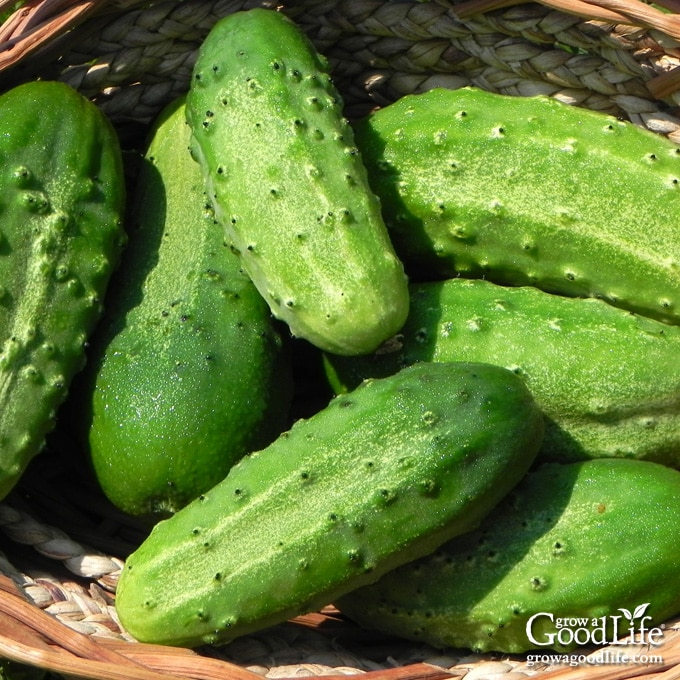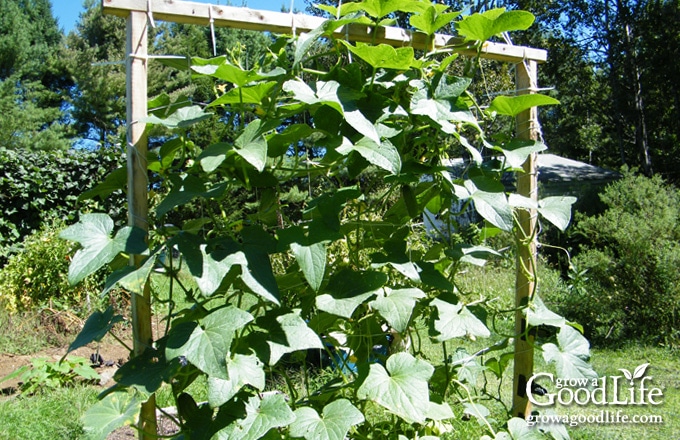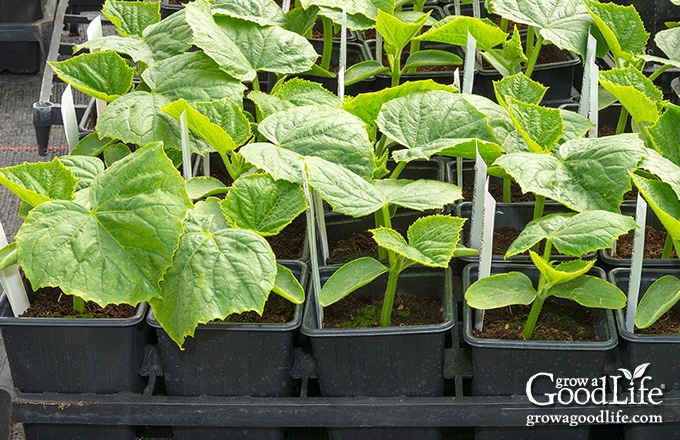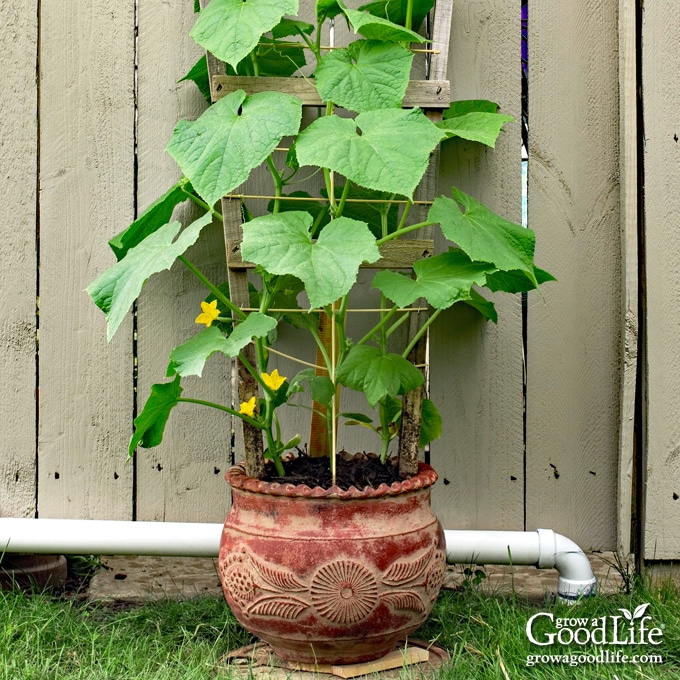How to Grow Cucumbers
This post may contain affiliate links, which means that I may receive a commission if you make a purchase using these links. As an Amazon Associate I earn from qualifying purchases.
Cucumbers are a summer favorite and are very easy to grow. Cukes can be enjoyed fresh, in salads, with dip, or preserved as pickles. Learn what you need to know about growing cucumbers in your vegetable garden.

No salad seems quite so delicious as one made with the first homegrown cucumber in all its crunchy, fresh, and sweet-tart perfection.
Anyone can learn how to grow cucumbers, even if you have never gardened before. Cucumbers can be grown in a container, or in the ground. There are so many different types of cucumbers to choose from, that you are sure to find one that matches your gardening space.
Cucumbers are a vining crop grown for their green fruit, which have a refreshing, mild, cool flavor. Cukes can be eaten raw, blended into smoothies, made into cucumber sandwiches, or pickled in many different ways.
This summer crop loves to sprawl, so give it plenty of room in your garden or consider growing vertically. Growing cucumbers upright on a trellis not only saves space, but also helps keeps the fruit clean and easier to pick.
About Cucumbers
Cucumbers (Cucumis sativus) are one of the oldest crops consumed by early humans, and has been in our lives for millennia. While the cucumber we are familiar with is said to have originated in India over 3,000 years ago, ancient varieties of the cucumber have dated back as early as 9750 B.C.
Members of the cucurbit family, cucumbers are closely related to zucchini, squash, and watermelon. Most varieties have green cylindrical shaped fruit, but some specialty cucumbers produce squat shaped yellow fruit, while others have multicolored patterned skin.
Varieties to Consider
There are so many types of cucumber available to grow, so it can be hard to know which one is best for your space and your needs. Here are some tips to help you choose the right variety.
Cucumbers are often categorized in seed catalogs as slicing, pickling, and specialty cukes. When choosing which cucumber to plant, consider how will use them, and how much growing space you have.
- Slicing Cucumbers: Depending on the variety, slicing cucumbers are about 8-inches long and have thick, dark-green skin, and tapered ends. They are delicious in salads and on a vegetable platter. Varieties of slicing cucumbers include Long Green Improved and Marketmore.
- Pickling Cucumbers: Pickling cucumbers are smaller, thin skinned, mild flavored, and stay crisp when pickled. Varieties include Boston Pickling, Calypso, National Pickling, and Parisian Pickle.
- Long Fruited Cucumbers: European, English and Asian cucumbers, sometimes called greenhouse cucumbers are thin-skinned cucumbers with a long, slender uniform shape, and undeveloped seeds. The flavor is mild, never bitter, and the skins are tender and don’t need peeling. Varieties include English Chelsea Prize, Suhyo Long, and Telegraph Improved.
- Specialty Cukes: Lemon cucumbers are pale yellow and round lemon-shaped, Mexican Sour Gherkins (Cucamelons) look like mini watermelons, and Silver Slicer is a white cucumber with a buttery texture.
In addition, consider your gardening space when choosing types of cucumbers to grow. Cucumbers are also often separated into two groups: vining and bush cucumbers:
- Vining cucumbers are the most common. The plants rapidly grow long vines with big leaves, up to 10-feet long depending on the variety. Cucumbers of this variety are best suited for large spaces where the vines can ramble, or grow vertically using a trellis supports, or cattle panel arches.
- Bush cucumbers are low growing, short plants and are ideal for growing in raised beds and containers. They are called bush cucumbers, but they do still vine out, but only to 2 to 4 feet. These plants are very well suited to growing in small places and container. Varieties include Spacemaster (slicer), Muncher (slicer), Homemade Pickles (pickler), and Little Leaf (pickler).
Tips for Growing Cucumbers
Cucumbers are easy to grow and prolific producers, so they make an ideal addition to any garden. Plant them in a section of the garden that receives full sun, with evenly moist, soil rich with organic matter, and you will be rewarded with a plentiful harvest. Here are tips for growing cucumbers:
When to Grow Cucumbers
Cucumbers are a warm weather crop that loves the heat, and can grow all summer long until killed by fall frost. The time to start seeds will depend on your last estimated frost date for your area. You can find your last frost date by contacting your local extension office or enter your zip code here at PlantMaps.com.
Cucumbers are especially sensitive to cold temperatures. Plan on planting cucumber transplants or direct sowing seeds several weeks after all danger of frost is past, and once the soil has warmed to at least 65˚F.
If you want to give your plants a head start, you can sow seeds indoors under lights approximately 4 weeks prior to your last frost date, and transplant to the garden after all danger of frost is past.
How to Prepare the Garden Bed
Cucumbers thrive on warm temperatures, abundant sunlight. Make sure your planting location receives at least 6 to 8 hours of sunlight each day. The plants grow best in loose, well draining, fertile soil with a neutral to slightly acidic pH range, around 6.5 to 7.0.
Before planting your cucumbers, prepare your garden beds by removing all the weeds, large clumps, and rocks. Add about 2 inches of aged compost to your soil, and work it in about 6 to 8 inches deep.
For gardeners living in colder climates, you can cover the garden bed with black plastic to help warm the soil. If the weather has been dry, prepare and water the bed very well the day before you transplant or sow seeds.
Forming Mounds or Hills
Planting cucumbers in mounds in the center of the garden bed provides room for the vines to stretch out. Piling soil into a small hill creates an elevated planting environment that will warm quickly, and drain well, much like a raised bed.
Pull up the soil into a mound of about 6-inches high, 2 feet in diameter, and about 3 feet apart. Flatten out the top and form into a shallow bowl to hold water. Each mound can support a group of 3 plants with plenty of space for the vines to ramble. Watering is easier because you can target the plants’ roots by filling the bowl shape at the top of the mound and let the water soak in deeply.
Growing Cucumbers Vertically
If you plan on growing vertically on a trellis, you should set up your supports before planting. I use permanent trellis structures attached securely to the north end of raised beds so it won’t shade other plants. These are made with 2 x 3s and wire fencing or nylon netting. An alternate option is to create an arch with cattle panel fencing secured with t-posts, for your climbing plants.

How to Plant Cucumbers
You can start cucumber seeds indoors under lights, purchase transplants from a garden center or greenhouse, or direct sow seeds in the garden.
Space the plants about 12 inches apart, in rows that are 3 feet apart, or in a single row along a trellis. If planting in hills, grow 3 plants per hill about 6 to 8 inches apart. Hills should be about 3 feet apart to allow area for the vines to spread.
Starting Cucumber Seeds Indoors
Start seeds about 4 weeks before your last expected frost date. Use good-sized pots that are at least 4-inches wide to support the quick growing roots.
Fill your containers with damp seed starting mix to within 1/2-inch of the top of the container. Poke holes in the center of your container about 1/2-inch deep, and add 1 or 2 seeds. Cover the seeds with soil, and mist the soil surface with water.
Cover the containers with a humidity dome to keep in moisture. Place the trays in a warm location or use a seedling heat mat. Be sure to harden off your seedlings, and transplant outdoors once the soil warms, and after all danger of frost is past.

Transplanting Seedlings
If you grow seedlings or purchase transplants from a warm greenhouse, they will need to be hardened off to adjust to the environment outdoors. The hardening off period allows your seedling to transition from the comfortable growing conditions under lights to the normal conditions they will experience in the garden. Learn How to Harden Off Seedlings with this step-by-step tutorial.
After your seedlings are hardened off, they are ready to be transplanted into their permanent location in the garden.
Prepare your garden beds ahead of time. If the weather has been dry, water the bed thoroughly the day before you plant. Choose a cloudy day with no wind and transplant in the late afternoon or evening to give your plants time to adjust without the additional challenge of the sun. Water the seedlings well after planting.

Direct Sowing Seeds
The simplest way to plant cucumbers is to sow them directly in the ground. You can direct sow your seeds in rows, mounds, or by simply poking holes and dropping in seeds. Learn more about Direct Sowing Seeds.
Sow seeds once the soil warms in spring to at least 65˚F, and about 2 weeks after your last frost date. Plant seeds about 1-inch deep and 6 to 8 inches apart. Thin down to 3 plants per hill and let the cucumber vines sprawl all over.
Cucumber seeds will germinate in soil temperatures ranging from 65˚F to 90˚F, and will sprout in 3 to 10 days. Germination will take longer at cooler temperatures. So you are not saving any time by sowing early. It is best to wait for warmer weather.
If you are using a trellis, sow seeds in a row near the base, spacing them about 12 inches apart. No thinning is needed if you are growing the plants on a trellis. You may need to guide the plants to the upright supports when they are small, but once their tendrils wrap around, the vines will climb up as the plant grows.
How to Care for Cucumber Plants
You can enjoy a continuous harvest of cucumbers all season long with a little care. Here are some tips to keep your plants healthy and thriving.
Watering
Proper watering plays a huge role in the growth and development of cucumbers. Make sure your plants receive consistent moisture either by rain or hand watering. Uneven and inconsistent watering causes the fruit to grow deformed and taste bitter.
Cucumbers should receive at least 1-inch of water per week either naturally from rain, or by watering by hand. Check the soil moisture by poking your finger in several inches deep. If the soil is dry, give your plants a good watering.
Water your plants in the morning or early afternoon. Try your best to avoid wetting the leaves, as this will open them up to the possibility of fungal disease. Instead, use drip irrigation, soaker hose, or water by hand to deliver water to the base of the plants.
Mulching and Weeding
I highly recommend that you mulch the garden beds soon after planting to help prevent weeds and hold in moisture. Add a generous layer of straw or shredded leaves to the beds keeping it a few inches away from the stems of your seedlings so it doesn’t smother the plants. Cucumbers that develop on mulch are cleaner and have fewer chance of damage due to slugs.
While the mulch will help, some persistent weeds will sprout through. The garden should be weeded regularly, especially in the early stage. Once the plants grow, their leafy canopy will shade the soil and stop most of the weeds from sprouting.
Fertilizing
Cucumbers are heavy feeders and require plenty of fertilizer. Finished compost provides a rich source of nutrients that your cucumbers rely on to grow strong, and you will only have to fertilize sparingly with more compost as the plant continues to grow.
If you worked in finished compost when you prepared the garden beds for planting, you are off to a good start. Side dress with additional compost once the plants begin fruiting.
Otherwise, you should feed with an organic fertilizer throughout the growing season. Apply this a week after the plant begins blooming, and then repeat this process every 3 weeks, or as the directions recommend.
Pollination
Ensure your cucumber flowers are being properly pollinated. Lack of pollination is one of the leading causes of deformed fruits and unproductive plants. You can attract bees and other pollinators by planting flowers nearby.
You can also opt to hand-pollinate your cucumber plants to increase productivity. Hand-pollination is actually quite simple and will help achieve a maximum yield. Learn How to Hand Pollinate.
I like to use a clean paintbrush to collect the pollen off of the stamen from the male flower, and gently roll the pollen onto the center of the female flower. Repeat this action until all female flowers have been pollinated.
Troubleshooting Pests and Diseases
Cucumbers are susceptible to a number of pests and diseases common to squash family members. When selecting which varieties to grow, look for varieties that are naturally pest resistant.
Row covers are helpful for preventing pests from harming young plants, but remove them once the plants bloom to allow pollinators to fertilize the blossoms.
Practicing good crop rotation, and cleaning up debris at the end of the growing season will help prevent early infestations of many pests and diseases that may overwinter in your soil. Here are some tips to help identify and troubleshoot some you may encounter:
Aphids are small sap-sucking insects. They often congregate in clusters on the underside of leaves. A heavy aphid infestation can cause malformed and discolored foliage, along with sticky excrement left behind by the pests. Luckily, aphids are very easy to control. Hosing them down with a stream of water is sometimes enough to dislodge them from the foliage. Eventually, beneficial insects such as wasps and ladybugs will come to the rescue.
Cucumber beetles are small striped or spotted insects that attack most members of the cucurbit family. Signs of cucumber beetle damage includes holes in both flowers and leaves, stunted plant growth, and scraped fruit. Hand pick adult beetles, and crush the eggs found under the leaves. Rotating crops from year to year can prevent an early infestation. In addition, mulching the area around the base of your plants is also helpful.
Squash Bugs target crops in the cucurbit family, including cucumbers, squash, pumpkins, and melons. Both adults and nymphs can be found gathered in clusters near the crown of the plant, and under leaves. They feed on foliage by piercing and sucking the sap from the plant. Excessive feeding kills the foliage and can cause the plant to struggle and reduce yields. Squash bugs can overwinter in plant debris, and other sheltered locations. Clean up the garden at the end of each season, and rotate your crops to prevent the early emerging squash bugs from easily finding your plants.
Squash Vine Borer is a type of moth larvae that attacks pumpkin plants by burrowing themselves in the stems of the plant. This weakens the plant, and oftentimes results in the plant’s death. Squash vine borers are incredibly hard to control once they’ve made their presence known. The key to never having to deal with them is prevention. Squash vine borers appear during the mid-summer, and are less likely to burrow into a mature, fortified plant. Starting your cucumbers early in the season will help deter them.
Anthracnose is a group of fungal diseases that is identifiable by dark spots all over your plant. Tragically, when anthracnose hits your plants, the best form of control is totally destroying the infected plant. Stringent prevention is key to stopping anthracnose altogether. Wet, warm conditions are a recipe for anthracnose to thrive and spread all over your garden. Growing cucumbers in well-draining soil enriched with compost helps prevent waterlogged soil. In addition, mulching will help prevent spores in the soil from splashing on to the foliage. You can reduce anthracnose by practicing good garden hygiene by removing and disposing of all plant debris at the end of the growing season.
Powdery Mildew is a fungal disease that gets its name from the powdery substance that forms on the leaves of plants. It starts with a few white spots and then expands coating the leaves. Over time, this mildew causes the foliage to turn yellow and die off. Powdery mildew is often the result of wet foliage combined with poor air circulation. To help prevent this, be sure to grow your cucumbers in full sunlight, and properly space the plants so that they are not overcrowded. Mulch and water close to the base of the plant to reduce the risk of wet foliage. Prune any foliage that has mildew on it and destroy it.
Downy Mildew once thought of as a fungus is actually a water mold that appears as yellow spots on the upper leaf surface between the leaf veins. These spots spread and eventually turn brown. The plant cannot photosynthesize on these yellow or brown spots. When the leaf is totally brown, it drops. If the plant loses too many leaves, the plant dies. Downy mildew can spread fast in humid conditions.
Blossom End Rot:
Are your cucumbers developing dark, sunken spots on the blossom-end of the fruit? If so, you might be dealing with blossom end rot. Blossom end rot is triggered by a calcium deficiency in the plant. Fruit that is affected by blossom end rot should be pruned because it won’t produce a good quality fruit.
While it is discouraging to see fruit be wasted, there are simple changes you can make to ensure it does not happen again.
While the soil itself most likely is abundant in calcium, the plant itself is struggling to absorb the calcium to nourish the fruit. Sometimes cold temperatures and wet soggy soil prevents nutrients from being absorbed.
Other causes calcium deficiency can include soil pH, and nutrient imbalances. If you are having problems with blossom end rot on many of your cubits, I recommend doing a soil test to make sure your soil is not too heavy in nitrogen (the nutrient that causes foliage development, but not fruiting), too acidic, or too basic. Always make sure your plants are getting a consistent flow of water in their care routine (1 inch of water a week is the standard).
How to Harvest Cucumbers
The best cucumbers are picked when they are young and slightly immature. Don’t allow your cucumbers to get too big. While humongous cucumbers are quite impressive, they taste bitter, have lots of seeds, and tougher skin than younger cucumbers.
Harvest cucumbers in the morning once the dew has evaporated from the foliage. Use a knife or a pair of scissors to cut the stem. Do not yank it off the vine as this could cause damage to the vine and stop the plant from producing.
The more often you harvest, the larger your yield in the long run! If cucumbers are left on the vine, the plant will focus on ripening the fruit instead of producing more foliage and cucumbers. Cucumbers that are left on the vine for too long will swell, harden, and turn orange as it ripens.
How to Grow Cucumbers in Containers
If you are tight on space or want to grow cucumbers in containers, seek out compact bush varieties. Some varieties to consider include Spacemaster (slicer), Muncher (slicer), Homemade Pickles (pickler), and Little Leaf (pickler).
Compact varieties grow shorter vines, 2 to 4 feet. So you may need to add a trellis support for the vines to grow vertically. Choose larger containers that are 24-inches deep and hold 25 gallons of soil. Plants growing on a trellis can get top heavy, so you want a large container to help anchor the plants and keep them upright.
Use a good quality potting mix suitable for growing vegetables in containers. Mix in a balanced slow release organic fertilizer, and then hydrate the soil by letting it soak for several hours. Fill the pot once the soil is evenly damp.
Sow seeds, or transplant seedlings, and water in well. A large pot can support up to 3 cucumber plants. If your containers are smaller, sow one plant per container. Keep the soil evenly moist until the cucumber plants are established. Then let the soil dry out a bit in between, and water when the top inch of soil is dry.
Plants in containers tend to dry out quickly, so water frequently during hot, dry temperatures or consider planting in a self-watering container.

How to Preserve Cucumbers
Cucumbers are mostly made of water, so it is important to store them in a way that helps them retain the most moisture. After harvesting, wrap your cucumbers tight in plastic and store them in the refrigerator crisper drawer, and they should last about 7 to 10 days.
While cucumbers are delicious eaten raw and added to salads, the bulk of my cucumber crop is devoted to preserving as canned pickles and relish.

Anyone can learn how to grow cucumbers with a little bit of patience and effort. It is a fun and rewarding experience, and you will be able to enjoy delicious cucumbers all summer long, and pickle plenty for your food storage shelves.
You May Also Like:
- 10 Vegetable Gardening Tips for Beginners
- Tips to Help You Decide What to Grow
- 8 Easiest Vegetables to Grow in Your Garden
Good planning is key to a successful vegetable garden
Whether you are new to growing your own food or have been growing a vegetable garden for years, you will benefit from some planning each year. You will find everything you need to organize and plan your vegetable garden in my PDF eBook, Grow a Good Life Guide to Planning Your Vegetable Garden.

